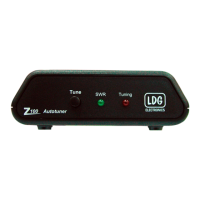Installation
Your Z-100 tuner is intended for indoor use only; it is not water resistant. If you use it outdoors
(Field Day, for example) you must protect it from rain. The Z-100 is designed for use with coax-
fed antennas. If you wish to use it with longwires or antennas fed with a balanced transmission line
(e.g., ladder line), an external balun is required. The LDG RBA-1:1 balun will work with short
random wires and the RBA-1 4:1 balun is suited for longer wires.
Connect the HF antenna jack on your transmitter or transceiver to the Transmitter jack on the back
of your Z-100 tuner using a coax jumper with standard PL-259 plugs. Attach your antenna lead-in
coax to the Antenna jack on the back of your Z-100 tuner.
Your AT-100Pro can interface directly with several popular transceivers. For Icom radios, it will
enable their “Tune” button to start a tuning cycle and provide power to the tuner.
For Icom radios that are AH-3 or AH-4 compatible, connect the white molex connector into the
radio’s tuner port. The power and radio plugs then connect to the tuner. The tuning process can
start by either pressing the tune button on the tuner or the radio.
For Yaesu FT-897 and 857, use the Y-ACC cable and plug the red end marked “Radio” into the
radio’s ACC port. Connect the black end marked “Tuner” into the tuner’s interface jack. The radio
does not supply power to the tuner. The tune button on the tuner is used for starting the tune
process.
If you are not using an Icom interface cable for powering the tuner, connect your Z-100 to a source
of DC power capable of providing 7 – 18 volts DC at 300 mA, using the provided coaxial
connector (center positive). You can use two standard 9-volt alkaline transistor radio batteries
connected in series (this is very handy for portable operation). If your radio is powered by 12 VDC,
you most likely can use the same power supply for the Z-100.
Grounding your tuner will enhance its performance and safety. LDG recommends that you connect
your tuner to a suitable ground; a dedicated ground rod connected to buried radials is preferred, but
a single ground rod, a cold water pipe or the screw that holds the cover on an AC outlet can
provide a serviceable ground. Your Z-100 tuner is ready to use!
An important word about power levels:
The Z-100 is rated at 125 watts continuous power input, at most. Many ham transmitters and
transceivers, and virtually all amplifiers, output well over 125 watts. Power levels significantly
exceeding specifications will definitely damage or destroy your Z-100. Be sure to observe the
specified power limitations.
6

